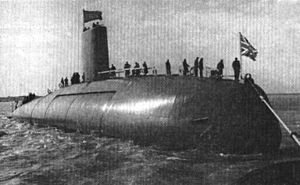
| |
| Class overview | |
|---|---|
| Builders | Vickers Armstrongs, Barrow-in-Furness |
| Operators | |
| Succeeded by | Valiant class |
| Built | 1959–1960 |
| In commission | 1963–1980 |
| History | |
| Name | HMS Dreadnought |
| Builder | Vickers Armstrongs, Barrow-in-Furness |
| Laid down | 12 June 1959 |
| Launched | 21 October 1960 |
| Commissioned | 17 April 1963 |
| Decommissioned | 1980 |
| Identification | Pennant number: S101 |
| Fate | Laid up at Rosyth Dockyard |
| Badge |  |
| General characteristics | |
| Class and type | Nuclear-powered submarine |
| Displacement | |
| Length | 265.7 ft (81.0 m) |
| Beam | 31.2 ft (9.5 m) |
| Draught | 25.9 ft (7.9 m) |
| Propulsion | 1 x Westinghouse S5W reactor, two geared steam turbines, one shaft, 15,000 shp (11,000 kW) |
| Speed | 20 knots (37 km/h; 23 mph) surfaced; 28 knots (52 km/h; 32 mph) submerged |
| Complement | 113 |
| Armament | 6 x bow tubes for 21 inch (533 mm) torpedoes, 24 rounds carried |
The seventh Royal Navy ship to be named HMS Dreadnought was the United Kingdom's first nuclear-powered submarine, built by Vickers Armstrongs at Barrow-in-Furness. Launched by Queen Elizabeth II on Trafalgar Day 1960 and commissioned into service with the Royal Navy in April 1963, she continued in service until 1980. The submarine was powered by a S5W reactor, a design made available as a direct result of the 1958 US–UK Mutual Defence Agreement.